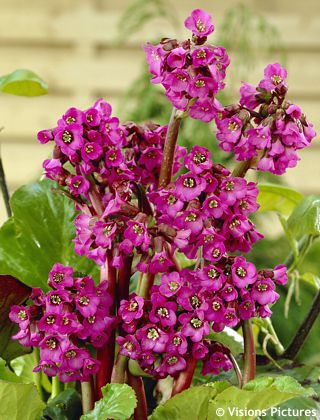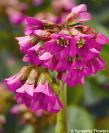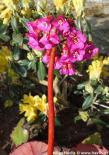Bergenia cordifolia 'PURPUREA'

Bergenia cordifolia 'PURPUREA'
elephant's ears
elephant's ears
| SIZE/TYPE | low or groundcovering |
|---|---|
| low perennial | |
| USUAL HEIGHT | 0.2-0.3m |
| USUAL WIDTH | 0.3-0.5m |
| LEAVES | evergreen broadleaf |
| COLOUR OF LEAVES |
 green green |
| FLOWERS | showy |
| COLOUR OF FLOWERS |
 purple red purple red
|
| BLOOMING TIME | April - May |
| LOCATION | full sun to shade |
| SOIL TYPE | any (acidic to alkaline) |
| SOIL MOISTURE REQUIREMENTS | none |
| USDA zone (lowest) | 4 (down to -34°C) |
| WINTER PROTECTION | |
| FOR ZONE 5+6 |

|
| FOR ZONE 7 |

|
| BELONGS TO CATEGORIES |
Perennials Evergreen broadleaf |
Elephant’s ears is a great name that best characterizes leaves of this perennial. They are truly shaped like real ears of baby elephants. Most varieties change their colour in autumn and winter adding extra interest to borders and beds, or making a winter window pot looking especially attractive, combined with dwarf conifers or small-leaved plants like hebes. Bergenia was described by German botanist Conrad Moench (1744-1805) and named in honour of another German botanist Karl August von Bergen (1704-1759).
Purpurea is considered the most widespread variety of elephant’s ears in Europe, and perhaps the oldest. It belongs among the pillars of evergreen groundcovers for both sunny and shady areas and has been used by landscape architects for many decades. In 1993, it received the prestigious Award of Garden Merit (AGM) for beauty and reliability from the Royal Horticultural Society of England (RHS). From late March to May it makes bell-shaped, deep purplish pink, campanulate flowers which appear atop dark maroon, firm, fleshy stems which grow about 30 cm tall. It scarcely reblooms from late summer.
The leaves are evergreen, broadly oval to round-cordate, glossy, and very large – up to 30 cm across. They are dark olive green in season and burgundy red from autumn to spring if they get enough sun. Use bergenia in places where you can appreciate live foliage in winter. The leaves create so much shade underneath that they are an ideal mulching alternative and at the same time they protect the ground from drying out.
Bergenia is a spreading, ground covering perennial with tough rhizomes. It likes moist but well-drained soil, rich in humus but will grow in almost any soil. Growing it in full sun will guarantee profuse flowering and richer foliage colours in autumn and winter. Avoid areas with constant drying winds. Its hardiness is at least -34°C (USDA zone 4), yet it benefits from mulching.
Last update 25-12-2023
Purpurea is considered the most widespread variety of elephant’s ears in Europe, and perhaps the oldest. It belongs among the pillars of evergreen groundcovers for both sunny and shady areas and has been used by landscape architects for many decades. In 1993, it received the prestigious Award of Garden Merit (AGM) for beauty and reliability from the Royal Horticultural Society of England (RHS). From late March to May it makes bell-shaped, deep purplish pink, campanulate flowers which appear atop dark maroon, firm, fleshy stems which grow about 30 cm tall. It scarcely reblooms from late summer.
The leaves are evergreen, broadly oval to round-cordate, glossy, and very large – up to 30 cm across. They are dark olive green in season and burgundy red from autumn to spring if they get enough sun. Use bergenia in places where you can appreciate live foliage in winter. The leaves create so much shade underneath that they are an ideal mulching alternative and at the same time they protect the ground from drying out.
Bergenia is a spreading, ground covering perennial with tough rhizomes. It likes moist but well-drained soil, rich in humus but will grow in almost any soil. Growing it in full sun will guarantee profuse flowering and richer foliage colours in autumn and winter. Avoid areas with constant drying winds. Its hardiness is at least -34°C (USDA zone 4), yet it benefits from mulching.
Last update 25-12-2023
SIZES and PRICES
GLOSSARY
|












